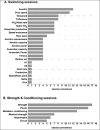Training Regimes and Recovery Monitoring Practices of Elite British Swimmers
- PMID: 31427881
- PMCID: PMC6683628
Training Regimes and Recovery Monitoring Practices of Elite British Swimmers
Abstract
Consistent prescriptions for event-specific training of swimmers are lacking, which points to likely differences in training practices and a potential gap between practice and scientific knowledge. This study aimed to analyze the distance-specific training load of elite swimmers, derive a consistent training sessions' description and reflect on the current recommendations for training and recovery. The individual training regimes of 18 elite British swimmers were documented by surveying four swim and two strength and conditioning (S&C) coaches. The annual and weekly training load and content were compared between swimmers competing in sprint, middle and long-distance events. Thematic analysis of the surveys was conducted to identify key codes and general dimensions and to define a unified classification of the swimming and S&C training sessions. Weekly training loads and content of the swim (ƞ2 - effect size; p = 0.016, ƞ2 = 0.423) and S&C (p = 0.028, ƞ2 = 0.38) sessions significantly differed between the groups. Long-distance swimmers swam significantly longer distances (mean ± SD; 58.1 ± 10.2 km vs. 43.2 ± 5.3 km; p = 0.018) weekly but completed similar number of S&C sessions compared to sprinters. The annual swimming load distribution of middle-distance specialists did not differ from that of long-distance swimmers but consisted of more S&C sessions per week (4.7 ± 0.5 vs. 2.3 ± 2.3; p = 0.04). Sprinters and middle-distance swimmers swam similar distances per week and completed similar number of S&C sessions but with different proportional content. Whereas all coaches reported monitoring fatigue, only 51% indicated implementing individualized recovery protocols. We propose a consistent terminology for the description of training sessions in elite swimming to facilitate good practice exchanges. While the training prescription of elite British swimmers conforms to the scientific training principles, recommendations for recovery protocols to reduce the risk of injury and overtraining are warranted.
Keywords: Strength and conditioning; fatigue; recovery practice; swimming distance; training load.
Figures



References
-
- Arroyo-Toledo J., Clemente V., Gonzalez-Rave J., Ramos Campo D., Sortwell A.D. (2013) Comparison between traditional and reverse periodization: swimming performance and specific strength values. International Journal of Swimming Kinetics 2(1), 87-96.
-
- Bonifazi M., Sardella F., Lupo C. (2000) Preparatory versus main competitions: differences in performances lactate responses and pre-competition plasma cortisol concentrations in elite male swimmers. European Journal of Applied Physiology 82(5-6), 368-373. - PubMed
-
- Braun V., Clarke V. (2006) Using thematic analysis in psychology. Qualitative Research in Psychology 3(2), 77-101.
-
- Chatard J.C., Steward A.M. (2011) Training Load and Performance in Swimming. World book of swimming: From Science to performance. Ed: Seifert L., Chollet D., Mujika I. Nova Sci Publishers, Inc. 359-373.
-
- Coburn J.W., Malek M.H. (2012) NSCA’s essentials of personal training. 2nd ed. Champaign, IL, Human Kinetics.
Publication types
MeSH terms
LinkOut - more resources
Full Text Sources
Miscellaneous
